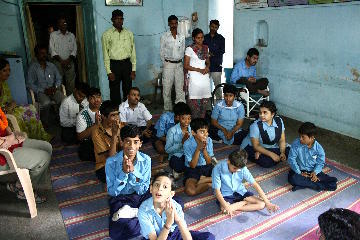
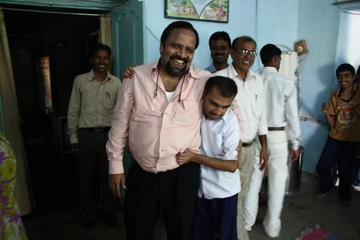
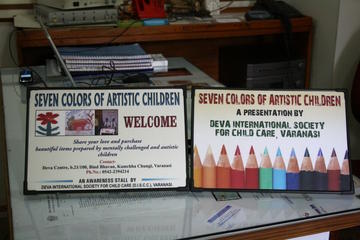
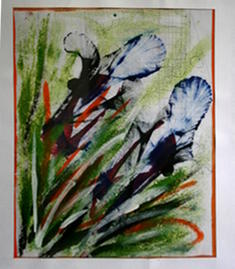
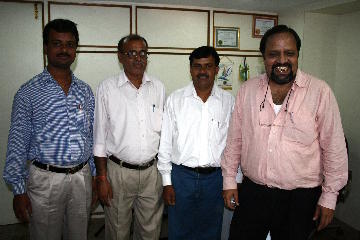
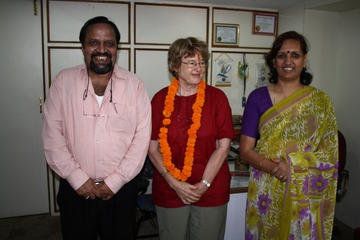
Impressions of DISCCPart 1, DEVA Center14-24 October 2008 |
When we arrived in Varanasi on 14 October 2008, we already had visited there twice: for 6 days in February 2008 with Jean and Daničle Porta and for 5 days in October 2007. Jean and Daničle are old friends who had introduced us to Jean-Max Tassel, founder and president of Deva Europe. It was through Jean-Max that we all came to know about DISCC and DEVA Europe.
During our first visit, we met Dr Tulsi and visited the DEVA Center and the Annapurna Center. We were very impressed with both. The encouragement and love given to the mentally handicapped children at the DEVA Center were extraordinary, particularly knowing that these children are generally considered by their families and others in India as punished by the gods. At the Annapurna Center it was wonderful to see the young womens' cheerfulness emanating from the feeling of being allowed to see others like themselves. They also learn skills that can help them become somewhat independent of their families by making things (by sewing, for instance) that could provide them with a small income. It was also fascinating to visit a real Indian village and to witness the everyday life in such a place.
During our second stay, we once again visited the DEVA Center and for the first time the center for leprosy victims at Sankat Mochan in Varanasi. The latter was a formative event for us. Leprosy is a mythical disease, symbolic of the worst kind of impurity and degradation. One recalls the deplorable conditions under which its victims have been ostracized and quarantined -- not to say imprisoned -- right up to current times. The movie "Ben Hur" comes to mind, where the hero lives with lepers in order to complete his fall from an aristocratic state into the lowest level of almost-humanity. Seeing how the victims of this terrible disease could be treated and live together in solidarity and in happiness (relative, of course) was a powerful experience for us. Nevertheless, the good aspects of their lives were in stark contrast to the ravages wreaked by the disease, most commonly on the hands and feet of its victims.
We also went to the Gangotri School just around the corner from our hotel in the Assi section of Varanasi. It was wonderful seeing these young children sitting under a big tree on mats and looking so happy at the chance they had to get an education, to wear a uniform like other school children, even though their parents could not afford either the uniforms or the other equipment needed for attending school -- books, notebooks, and so forth. These children mostly come from Nagwa, a very poor section of Varanasi, and a large number of the families are immigrants and totally impoverished. They depend on the money the children collect from begging on the ghats of the Ganges, so convincing and motivating the parents to let their children attend school is the first big hurdle to overcome for DISCC. Gangotri School was then on its original site, but it has since moved to a building where there are actual classrooms and sanitary facilities.
Since then, we had asked ourselves the question, "What can we do for DEVA?" and come up with two answers. So this time we arrived for ten days in Varanasi with two projects underway. First, in collaboration with Jean-Max, we had created the web site for DEVA Europe. So we came to Varanasi to discuss and finalize the site with Tulsi, as well as to discuss the creation of a site uniquely for DISCC. Also, Siv and Dr Deepika (the wife of Tulsi, whom we had also met in 2006) were prepared to do a workshop on English teaching for DEVA teachers.
After a day of much needed rest following a 10-day whirlwind tour of Nepal, we participated in starting the day for the children of the DEVA Center. The staff and the children were together in the common room, the children seated cross-legged in Indian style on the floor. First, we all together chanted four times the Hindu mystic sound "Om" (sometime transliterated "Aum"), with a silent interval in between. Then the children recited a poem which we were told was of a non-denominational sort. And afterwards, they sang the Indian national anthem, which we learned was written by the great Indian-Bengali author and poet, Rabindranath Tagore. l'atelil'aDuring the ensuing speech of welcome, Tulsi explained that this ritual helped to calm the children and to initiate a day of cooperation.
 |
 |
| The children | Tulsi and a former child, now an assistant |
 |
 |
| Signs for a sale; "autistic" becomes "artistic" | A beautiful flower drawing |
 |
 |
| Sharma, Saxena, Shyamjee and Tulsi | Tulsi, Siv and Deepika |
Afterwards, we admired some lovely objects (pictures, curios) the children had made to be sold. In particular, one child had painted a beautiful picture of flowers.
Tulsi then explained his principles concerning children's education. He sees this as an equilateral triangle of development, with the child at the center and with the following goals at the apexes: